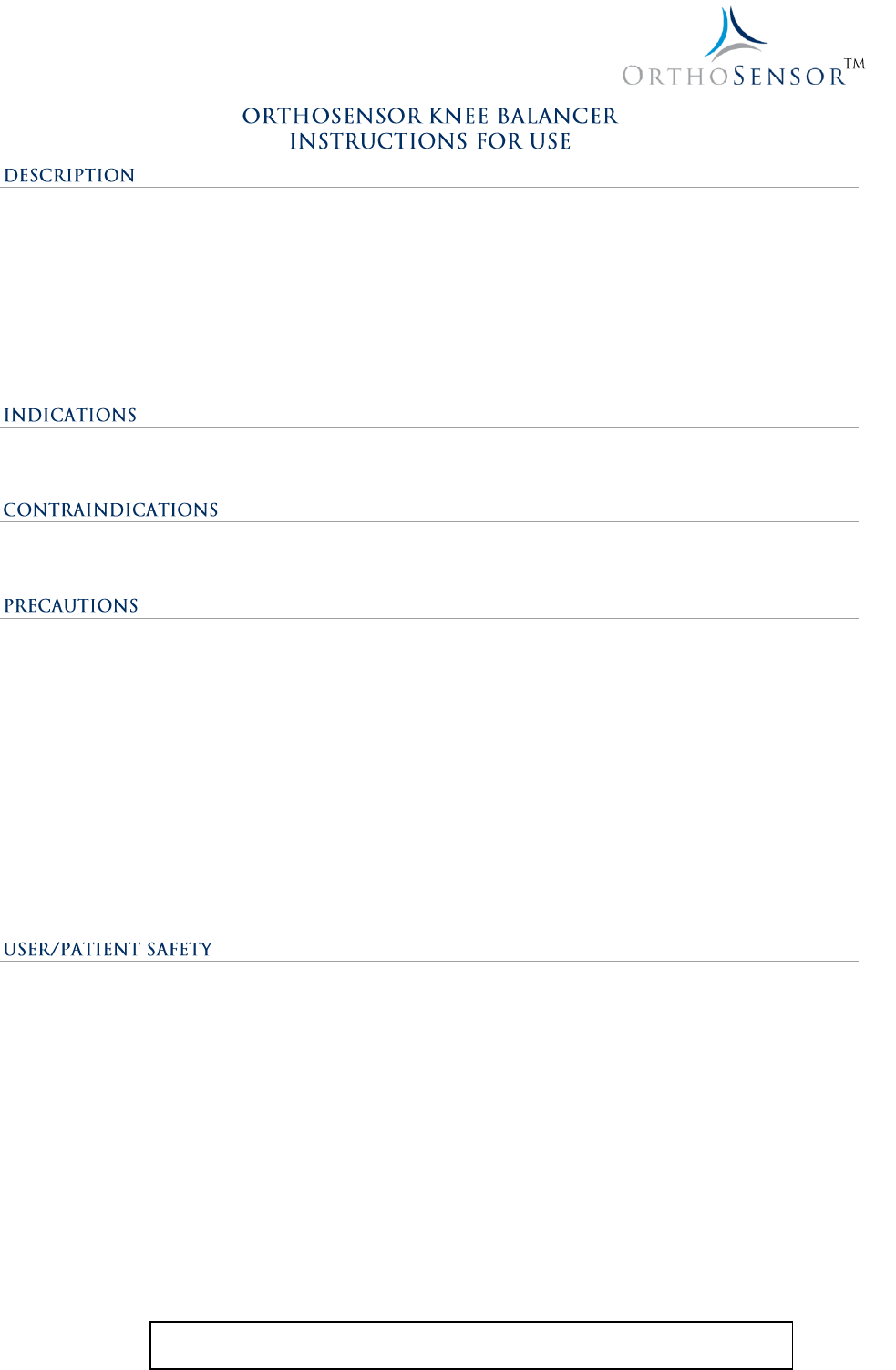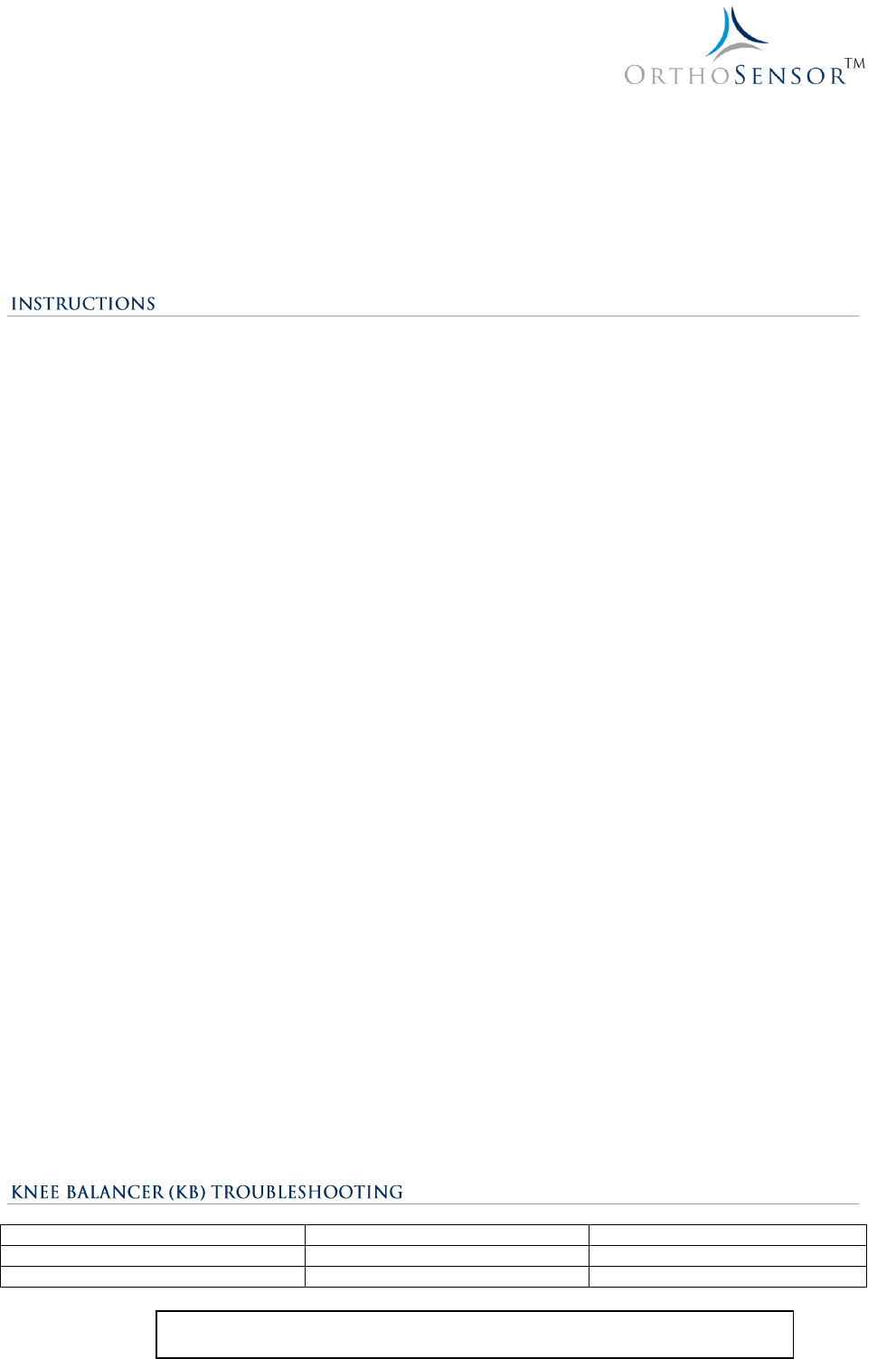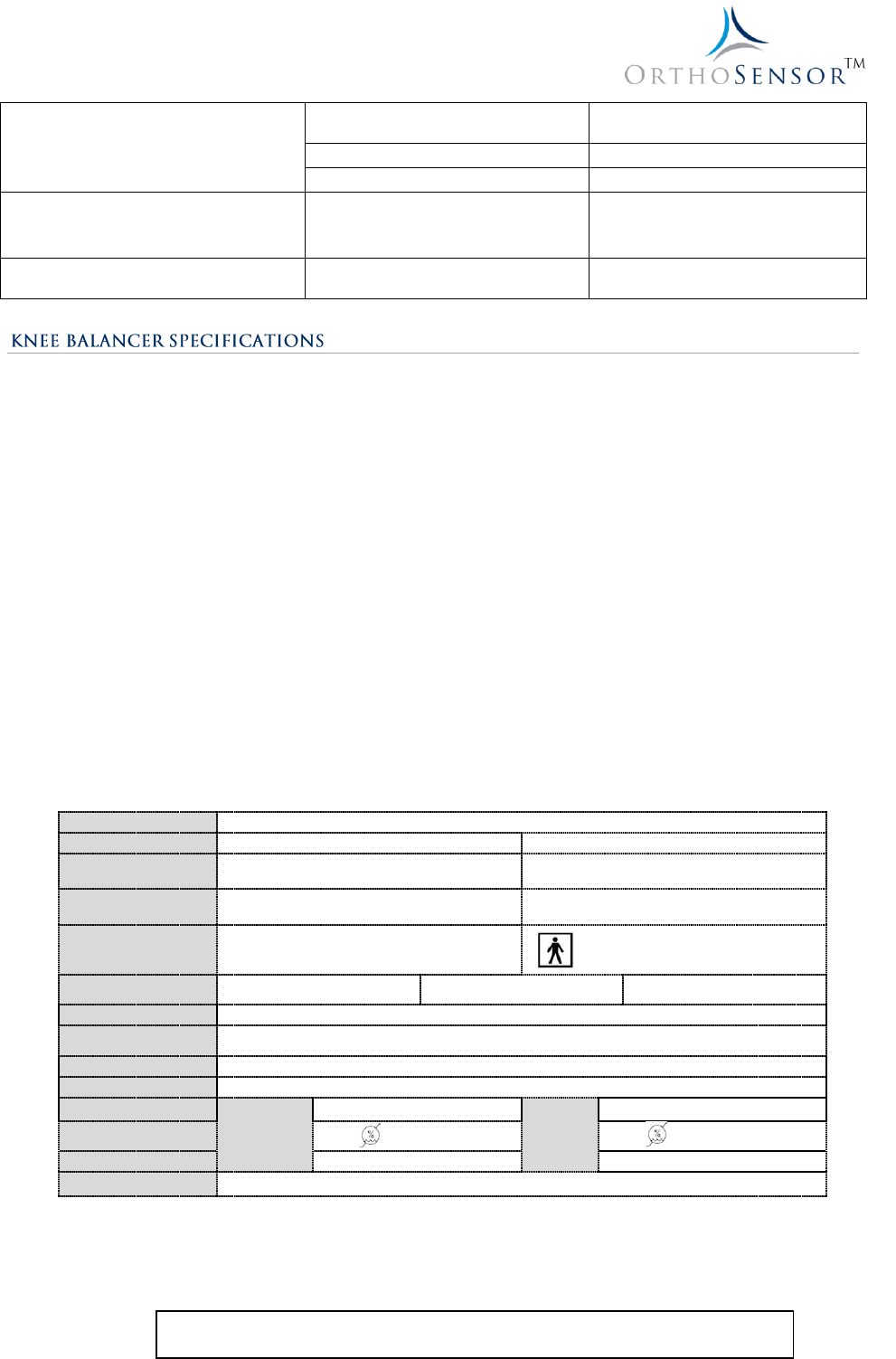Orthosensor ORTHOSNSR2 Intra-Operative Knee Arthropasty Device Used For Soft Tissue Balancing and Alignment User Manual
Orthosensor, Inc Intra-Operative Knee Arthropasty Device Used For Soft Tissue Balancing and Alignment
Contents
- 1. User Guide
- 2. User Manual
User Manual

OrthoSensor, Inc
1560 Sawgrass Corporate Pkwy, 4th Floor
Sunrise FL, 33323
www.orthosensor.com
LB-03000-001 Rev B
Dec. 2012
For further information, contact the OrthoSensor Customer Service Center by phone at 954-577-7770 or by e-mail at
customerservice@orthosensor.com or go to www.orthosensor.com.
The OrthoSensor Knee Balancer provides a means to dynamically balance the knee during knee replacement surgery.
The Knee Balancer is a “smart” tibial insert trial that measures dynamic loads in the medial and lateral compartments of the
knee and wirelessly transmits the measured load data to the OrthoSensor LinkStation for surgeon visualization. Individual
OrthoSensor Knee Balancers are packaged sterile, for single patient use with a Shim Set for thickness adjustments.
The OrthoSensor LinkStation is required for use of the Knee Balancer. The LinkStation contains a computer and all peripheral
equipment required to display the measured load data by providing a graphical and numerical presentation of the loads in both
the medial and lateral compartments of the knee. Refer to the OrthoSensor Device Activation and LinkStation Operation User
Guide for additional details on these components.
The OrthoSensor Knee Balancer is a tool for the adjustment of the femoral knee implant to reduce instability from flexion gap
asymmetry. The Knee Balancer is sterile, for single patient use.
Any active or suspected latent infection in or about the knee joint.
Refer to Knee System IFU for additional contraindications.
Read and follow instructions for proper use and interpretation of force data displayed.
Strict adherence to the indications, contraindications, precautions and user/patient safety for this product is essential.
Refer to appropriate Knee System IFU for additional precautions.
Data from OrthoSensor Knee Balancer is for reference purpose only and should not be the sole basis for surgical decisions.
OrthoSensor Knee Balancer internal components are non-sterile. Immediately discontinue use of device if any cracks,
damage, or internal fluid is observed. Failure to observe these warnings may expose patient to non-sterile material.
OrthoSensor Knee Balancer consists of sophisticated calibrated internal microelectronics. Avoid direct impact with mallet or
other instruments when possible.
Handle OrthoSensor Knee Balancer with care when inserting, adjusting shim size or removing from tibial tray.
Do not forcibly impact femoral trial on to femur with Knee Balancer in place in tibial tray.
Do not attempt to use OrthoSensor Knee Balancer without selection and use of proper shim and appropriate sized tibial tray.
When attaching Shim to OrthoSensor Knee Balancer, take care and caution to properly slide shim onto Knee Balancer
engaging/snapping components together. When detaching a Shim from the Knee Balancer, detach anterior lip first, do not
pry off posterior edge.
Knee Balancer and Shim Sets are supplied as single-use sterile devices. Do not reuse or re-sterilize.
If Knee Balancer or Shim Set packaging is open or damaged, do not use and immediately return to OrthoSensor.
Do not use Knee Balancer after the expiration date on the package labeling.
Do not use the Knee Balancer in a tibial tray without a Shim attached.
The measurement load range of the Knee Balancer is 5 to 40 pounds per condyle. Contact OrthoSensor for additional data
regarding Knee Balancer accuracy.
Maximum safe allowable load for the OrthoSensor Knee Balancer is 70 lbs per compartment.
If maximum safe allowable load of 70 lbs is reached in either compartment, the Knee Balancer must be removed from the
knee joint and placed on a flat surface to allow the device to “re-zero” to recalibrate the device load sensors.
If the physician perceives a difference between the loads displayed on the screen and the physical feel, the physician should
either replace the sensor or continue the procedure using their standard trial technique and best clinical judgment.
Do not load the Knee Balancer at its edges.
Do not subject Knee Balancer or Shims to loads beyond the maximum allowable load.
Do not impact / hit the Knee Balancer or any objects in contact with the Knee Balancer as this may result in damage to the
exterior of the device.

OrthoSensor, Inc
1560 Sawgrass Corporate Pkwy, 4th Floor
Sunrise FL, 33323
www.orthosensor.com
LB-03000-001 Rev B
Dec. 2012
For further information, contact the OrthoSensor Customer Service Center by phone at 954-577-7770 or by e-mail at
customerservice@orthosensor.com or go to www.orthosensor.com.
Do not use a prying device during surgical procedure while the Knee Balancer is in place as this may result in damage to the
exterior of the device.
The Knee Balancer contains non-sterile, non-medical grade internal components. If the Knee Balancer housing is damaged or
cracked during the procedure, take appropriate steps to promote patient safety.
Do not disassemble or otherwise modify the Knee Balancer or Shims.
Do not use Knee Balancer if it appears to be functioning improperly.
Observe all warnings and alarms generated by the OrthoSensor LinkStation.
Federal law restricts this device to sale by or on the order of a licensed physician.
1. Determine the specific size Knee Balancer required. Remove pouched Shims and Knee Balancer from the box and put
on the shelf of the OrthoSensor LinkStation. DO NOT OPEN POUCH SEALS.
2. Record Knee Balancer serial number (S/N) onto patient and hospital records as required.
3. To activate the Knee Balancer:
a. Locate the OrthoSensor Sensor Assisted Surgery (SAS) icon on the screen of the LinkStation and activate the
SAS software.
b. With the product still in the sealed pouches, place the device directly over the magnet on LinkStation shelf;
an orange LED light will illuminate on the articulating surface of the Knee Balancer. Do not move the device
until you observe the following:
i. LED turns off after approximately four (4) seconds.
ii. Graphic User Interface (GUI) launches.
iii. Load Sensor initialization progress bar appears and completes.
c. Device may now be removed from magnet.
4. The GUI will automatically prompt selection of left or right leg. Select appropriate leg.
5. Zero Device
a. Horizontal Zero, Step One
i. Place sterile packed device flat on LinkStation shelf.
ii. Gently secure medial and lateral edges to ensure device is flat.
iii. Click the “Zero” button on the GUI.
iv. Progress bar will appear and complete.
b. Horizontal Zero, Step Two
i. Rotate the device 180º.
ii. Gently secure medial and lateral edges to ensure device is flat.
iii. Click the “Zero” button on the GUI.
iv. Progress bar will appear and complete.
c. Vertical Zero, Step Three
i. Place sterile packed device flat against LinkStation post. The flat non-articulating surface of the
device should be against post with posterior edge oriented toward the floor.
ii. Click the “Zero” button on the GUI. Note that this step is instantaneous and has no progress bar
for this step.
6. With the Knee Balancer now activated, pass the sealed pouches to the nurses within the sterile field of the OR.
7. Open double sealed pouches per hospital protocol (Knee Balancer and Shim Set.)
8. With Knee Balancer and Shims removed from the pouches, apply designated Shim to bottom of Knee Balancer.
9. To remove the Shim, or exchange for another size, simply unsnap the anterior lip of the attached Shim and replace.
10. With the Knee Balancer and Shim attached, physician should manually compress / apply load to the Knee Balancer
and verify the response on the LinkStation screen prior to placing Knee Balancer into the tibial tray.
11. Confirm that the Knee Balancer with Shim is fully seated when placed in the tibial tray.
12. Flex the joint throughout its full range of motion to ensure appropriate response on the LinkStation.
13. Proceed with total knee replacement process per physician / hospital protocol.
14. Upon completion of the procedure, deactivate the Knee Balancer by pressing the Power Button on the GUI.
15. Dispose of Knee Balancer per institutional guidelines for biohazardous medical waste.
Issue
Cause
Solution
Knee Balancer (KB) LED does not light up
KB batteries are dead
Discard KB and replace
KB not transmitting data to LinkStation
KB is out of wireless range
Move LinkStation closer to KB

OrthoSensor, Inc
1560 Sawgrass Corporate Pkwy, 4th Floor
Sunrise FL, 33323
www.orthosensor.com
LB-03000-001 Rev B
Dec. 2012
For further information, contact the OrthoSensor Customer Service Center by phone at 954-577-7770 or by e-mail at
customerservice@orthosensor.com or go to www.orthosensor.com.
Move LinkStation to achieve an
unobstructed line-of-sight to the KB
KB is powered off
Activate with LinkStation magnet
KB batteries are low
Discard KB and replace
KB breakage
KB loaded beyond limit
KB internal components are non-
sterile and non-medical grade. Ensure
patient safety. Discard KB and replace
Lag in reported data
Software latency
Maintain knee position until data
settles (approximately 5 seconds)
This device complies with Part 15 of the FCC Rules. Operation is subject to the following two conditions: (1) this device may not
cause harmful interference, and (2) this device must accept any interference received, including interference that may cause
undesired operation.
This equipment has been tested and found to comply with the EMC limits for the Medical Device Directive 93/42/EEC (EN
55011 Class B and EN 60601-1-2.) These limits are designed to provide reasonable protection against harmful interference in a
typical medical installation. This equipment generates, uses, and can radiate radio frequency energy and, if not installed and
used in accordance with the instructions, may cause harmful interference to other devices in the vicinity. However, there is no
guarantee that interference will not occur in a particular installation. If this equipment does cause harmful interference, which
can be determined by turning the equipment off and on, the user is encouraged to try to correct the interference by one or
more of the following measures:
- Reorient or relocate the receiving device
- Increase the separation between the equipment.
- Consult OrthoSensor for help.
This device complies with Part 95 of the FCC rules. This device may not interfere with stations operating in the 400.150–
406.000 MHz band in the Meteorological Aids, Meteorological Satellite, and Earth Exploration Satellite Services and must
accept any interference received, including interference that may cause undesired operation.
Modification of this device may void the user’s authority to operate the equipment under the FCC rules above.
Model:
Load Balancing System – Knee Balancer
Quantity:
1
Type:
Single Procedure Only. Do not resterilize
B
Sterile:
Ethylene Oxide
yQ
Device Type:
Type BF
FCC ID:
XNL-ORTHOSNSR1
XNL-ORTHOSNSR2
Operating Range:
Y6.5 ft [2m] Unobstructed
Mode of Operation:
Temporary (single-use) D
Power Supply:
Internally powered at less than 3.3 VDC
Battery Life:
40 minutes (approximate)
Temperature:
Operation
15˚l37°
Storage
0˚l50°
Relative Humidity:
30% 100%, submersion
10% 50%, non-condensing
Atm Pressure:
470-1060 hPa
360-1060 hPa
Rx Only:
U.S. Federal Law restricts this product to sale by or on the order of a physician